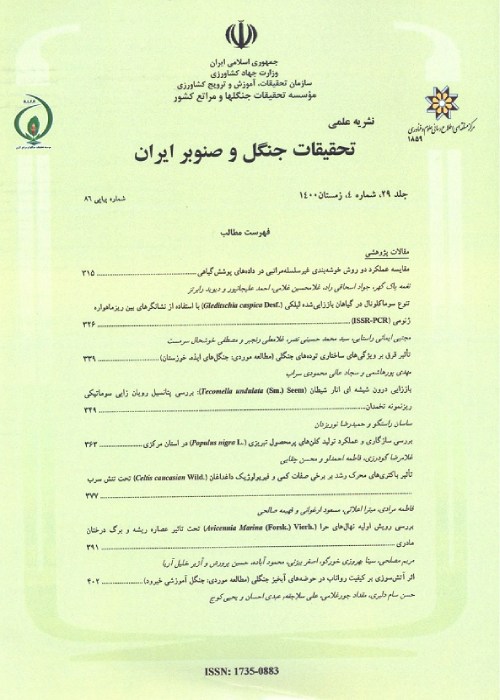Spatial Pattern, competition and spatial association of trees in Mixed Hornbeam Stands using univariate and bivariate Ripley's K-function (case study: Reserve area, district 3 of Asalem forests)
Author(s):
Abstract:
In order to study the competition and spatial association of trees in mixed Hornbeam stands, two 1-ha sample plots (100m×100m) were selected in the reserve area of Asalem forests in Guilan. In each plot, species and diameter at breast height (DBH) of all trees with a diameter > 7.5 cm were recorded and mapped using slope-corrected distance and azimuth from southwest corner of each plot. Distances and azimuths were later transformed to Cartesian coordinates, and all of the measured trees were assigned to one of four diameter size classes: ST (Small Timber, (DBH ≤ 32.5 cm), MT (Medium Timber, 32.5 < DBH ≤ 52.5 cm), LT (Large Timber, 52.5 < DBH ≤ 72.5 cm) and ELT (Extra-Large Timber, DBH > 72.5). Spatial patterns of the entire trees as well as the spatial associations among tree size classes (Intra-specific) and among species (Inter-specific) were analyzed by univariate and bivariate Ripley’s K-function. Results showed that the two stands exhibited a clustered distribution. Furthermore, the interaction between the ST class and other classes was significant (P<0.05). Although we found a positive correlation between the ST and other tree classes, spatial distribution of trees showed different patterns at different spatial scales. The starting point of the attraction in LT and ELT classes was observed at a small scale, whereas it tended towards independent associations in MT class at scale of 10 meter (P>0.05). The inter-specific investigation revealed that Fagus orientalis and Carpinus betulus trees tend towards an independent association at 1-20 meter scales. At higher scales they showed yet a negative correlation. Moreover, F. orientalis was significantly and negatively correlated to Alnus subcordata at small scales. However, their mutual intra-specific and inter-specific effects were different due to the fact that different natural stands have variety of demands during their life cycle. Therefore, it may not necessarily conform to their response to natural processes. This study concludes a founded understanding of spatial pattern of stands to be a helpful indicator for managing forests based on the currently operational close- to- nature silvicultural system.
Keywords:
Language:
Persian
Published:
Iranian Journal of Forest and Poplar Research, Volume:23 Issue: 1, 2015
Pages:
37 to 52
magiran.com/p1445708
دانلود و مطالعه متن این مقاله با یکی از روشهای زیر امکان پذیر است:
اشتراک شخصی
با عضویت و پرداخت آنلاین حق اشتراک یکساله به مبلغ 1,390,000ريال میتوانید 70 عنوان مطلب دانلود کنید!
اشتراک سازمانی
به کتابخانه دانشگاه یا محل کار خود پیشنهاد کنید تا اشتراک سازمانی این پایگاه را برای دسترسی نامحدود همه کاربران به متن مطالب تهیه نمایند!
توجه!
- حق عضویت دریافتی صرف حمایت از نشریات عضو و نگهداری، تکمیل و توسعه مگیران میشود.
- پرداخت حق اشتراک و دانلود مقالات اجازه بازنشر آن در سایر رسانههای چاپی و دیجیتال را به کاربر نمیدهد.
In order to view content subscription is required
Personal subscription
Subscribe magiran.com for 70 € euros via PayPal and download 70 articles during a year.
Organization subscription
Please contact us to subscribe your university or library for unlimited access!



